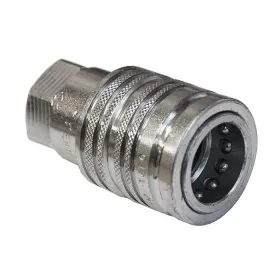Most hydraulics engineers are well aware that proper hose routing often means accommodating machine motion without overly stressing the hose, or letting it rub and abrade against other hoses or machine components. Otherwise, hose can prematurely fail, resulting in leaks, machine damage, downtime, costly environmental contamination and, potentially, a hazard to nearby personnel.

Hydraulic hose rotary joint
Swivel-type fittings are designed to allow the coupling and hose connection to rotate, which prevents twisting, kinking and excessive bending. That can extend hose life and reduce maintenance needs. It can also make for more efficient system plumbing. Using rotary joints can reduce the length of hose required between connections, eliminate the need for bent tubing to accommodate angled connections, and often can be connected directly to the hose line without adapters. Because swivel joints move, they can compensate for hose length changes when the system pressurizes and absorb hydraulic surges and shocks in a line.
Thus, many applications can benefit from the use of hydraulic hose rotary joints. These components permit an extensive range of articulation and movement in equipment operation and eliminate torque and twisting in hydraulic hoses. They can also simplify hose installation and maintenance.
Components
They consist of two major components, a stem and housing that can rotate relative to one another, as well as internal seals and bearings. Depending on the design, rotation can be unrestricted or somewhat less than 360°. Some rely on ball bearings to control movement, others have so-called ball-less designs with plain thrust bearings.
Types
Two basic types are in-line, where the opposing stem and housing fluid ports lie on a common axis; and 90° swivels, where the housing's fluid port is positioned to rotate on a plane 90° to the stem axis.

Hydraulic hose rotary joint
Applications
They are built to handle high pressures - often in excess of 5,000 psi - offer leak-free performance, resist hydraulic shock and side loads, and won't pull apart in operation. Over time the seals, back-up rings or bearings can eventually wear out, but many designs permit simple repair with seal replacement kits.
The swivel or hose should be mounted to the machine structure to ensure proper alignment and freedom of movement. While rotary joints are typically designed to allow free rotation with minimal friction, engineers should be aware that the weight of the attached hose, tubing or fittings - as well as the weight of the contained hydraulic fluid - may be substantial enough to place excessive side loads or bending moments on the swivel. The connection must be specified to handle such loads, or the seals may prematurely wear and leak. Side loading also causes excessive wear on the bearing surfaces and inhibits smooth swivel joint operation.
Hydraulic swivels are used in a wide range of rotary applications. Typical examples include grapples, forestry attachments, lift cranes and utility boom trucks, railroad maintenance equipment, demolition shears, and mobile excavators. And in this IoT era, special hydraulic rotary joints can be combined with electrical slip rings to transfer power or data signals. In addition to simple hydraulic swivels, a number of companies make rotary unions and rotating manifolds that transmit fluid from a single housing to multiple lines.
Design parameters
As with any other hydraulic component, engineers should consider a number of important design parameters. Swivel housings are available in steel and stainless steel, brass, aluminum and other common materials. Fluid compatibility with the specified materials is, of course, a must, and typical seal options include nitrile, ethylene propylene, neoprene and fluoroelastomer, to name a few.

Hydraulic hose rotary joint
Other considerations include pressure rating, internal flow characteristics and pressure losses, permissible rotational speed and torque requirements, SAE or ISO fluid ports options, and the ability to handle a range of ambient and fluid temperature ratings.
Many designs have an external exclusion seal to prevent ingression of contaminants, but it's always recommended to protect the swivel from dirt and abrasives whenever possible. For operation in harsh or corrosive conditions, a protective cover or elastomeric bellows are possible options.
And almost always, price is an important consideration. The cost of a rotary joint can be more than offset by cost-reduction benefits such as greater system design flexibility, improved system routing with less hose, simpler and quicker installation, fewer adapters and tube fittings, and longer service life.
We are a hydraulic hose rotary joint supplier. If you are interested in our products, please contact us now!















